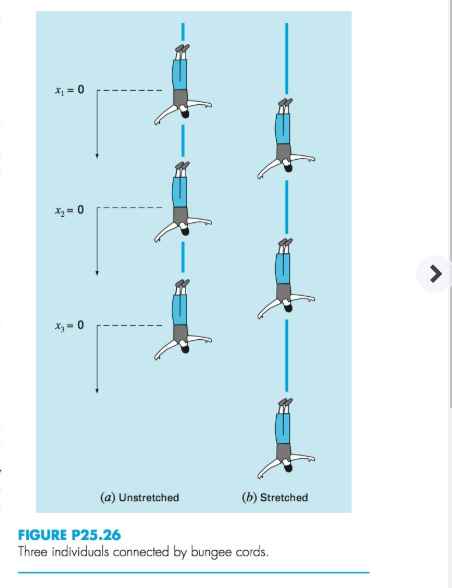
Concept explainers
Three linked bungee jumpers are depicted in Fig. P25.26. If the bungee cords are idealized as linear springs (i.e., governed by Hooke's law), the following differential equations based on force balances can be developed
where

from its equilibrium position (m), and
Want to see the full answer?
Check out a sample textbook solution
Chapter 25 Solutions
Numerical Methods for Engineers
Additional Math Textbook Solutions
Precalculus: Mathematics for Calculus (Standalone Book)
College Algebra Essentials (5th Edition)
Pathways To Math Literacy (looseleaf)
College Algebra (Collegiate Math)
Elementary Statistics ( 3rd International Edition ) Isbn:9781260092561
Intermediate Algebra (13th Edition)
- Remix 4. Direction Fields/Phase Portraits. Use the given direction fields to plot solution curves to each of the given initial value problems. (a) x = x+2y 1111 y = -3x+y with x(0) = 1, y(0) = -1 (b) Consider the initial value problem corresponding to the given phase portrait. x = y y' = 3x + 2y Draw two "straight line solutions" passing through (0,0) (c) Make guesses for the equations of the straight line solutions: y = ax.arrow_forwardIt was homeworkarrow_forwardNo chatgpt pls will upvotearrow_forward
- 18) Find all the complex cube roots of -2i. Leave your answers in polar form with the argument in degrees.arrow_forward9) Write an equation for the hyperbola. 2+ -6-5-4-3-2 -2- -4- -5+ + 23 45 6xarrow_forward8) Find an equation for the hyperbola with vertices at vertices at (±7, 0) and foci at (±9, 0).arrow_forward
 Linear Algebra: A Modern IntroductionAlgebraISBN:9781285463247Author:David PoolePublisher:Cengage Learning
Linear Algebra: A Modern IntroductionAlgebraISBN:9781285463247Author:David PoolePublisher:Cengage Learning
